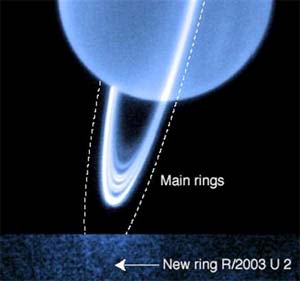 |
|
Scientists have recently discovered that the outermost ring surrounding Uranus is bright blue – (Photo: Reuters) |
The outermost ring around Uranus, discovered last year, is bright blue, according to researchers. With this finding, Uranus becomes the second planet in the Solar System known to have a blue ring, after Saturn.
All other rings surrounding Jupiter, Saturn, Uranus – the seventh planet in the Solar System – and Neptune are red.
In a scientific journal published on April 7, researchers stated that it is likely no coincidence that both blue rings are associated with small moons.
According to astronomers worldwide, each blue ring contains a moon of the planet, while the red rings are merely reflections of light. They believe that as the moons orbit the planet, they sweep away most of the larger cosmic objects, leaving behind dust and tiny cosmic particles, which reflect blue light more than the red rings do.
“The blue color indicates that this ring is primarily made up of ultra-fine materials, much smaller than those in other rings, which are usually red,” said Imke de Pater, a professor of astronomy at the University of California, Berkeley.
These ultra-fine materials primarily scatter and reflect blue light, similar to the small molecules in the atmosphere that give Earth’s sky its blue color.
 |
 |
|
Diagram of the outer rings of Uranus… |
… and Saturn |
Along with the blue ring, astronomers have also discovered a new red ring surrounding Uranus. Thus, to date, astronomers have identified four rings around this distant planet.
American astronomers emphasize that while the ring closest to Uranus has an unclear color and the farthest ring is light blue, the two newly discovered rings (red and blue) show that their colors are determined by the different light reflections of the molecules that make up the rings at varying distances from the surface of Uranus.
TUONG VY


















































